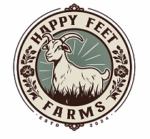If you’re a goat owner, you’ve probably realized by now that these lovable, quirky creatures are equal parts escape artists, garbage disposals, and bottomless pits. Feeding goats isn’t just about tossing them a flake of hay and calling it a day—it’s about balance, planning, and a little bit of science. And if you’re anything like us here at Happy Feet Farm, you’ve also realized that feeding goats on a budget requires creativity, patience, and maybe a calculator or two. Let’s dig in!
The Science of Goat Nutrition (AKA Not Just Corn and Dreams)
Goats are ruminants, meaning their stomachs are built for processing fibrous plants. That doesn’t mean they can survive on cardboard and weeds (though they might try). A proper goat diet combines forage—like hay or pasture—with grains and supplements for energy, protein, and essential minerals.
At Happy Feet Farm, we’ve come up with a mix that works well for our herd of 14 goats. Here’s what our daily feed plan looks like:

- Grain Mix: 6.5 pounds of feed per day, split among the entire herd.
- Unlimited Hay: The goats munch on this all day because, let’s face it, chewing is their favorite hobby.
Now, let’s break down our custom feed mix:
- 91 pounds of ground corn (because goats love it and it’s affordable! Provides Energy)
- 3 pounds of calcium (to keep those bones and milk production strong)
- 15 pounds of soybeans (for protein-packed energy)
- 50 pounds of oats (because who doesn’t love a little variety?)
This mix lasts us about half a month, and while it’s working great, I’ll be honest—mixing feed every two weeks is getting old. That’s why we’re upgrading to a 55-gallon plastic drum for larger batches. With this upgrade, we’ll only need to mix once a month, saving us time and sanity.
Pro tip: If you’re new to feed mixing, check out the Clemson Feed Calculator. This handy tool helps you balance your mix based on your goats’ nutritional needs, so you’re not just winging it.
Why the Weight of Grains Matters (and What the Heck is a Bushel?)
If you’re buying grains in bulk, you might encounter the term “bushel.” A bushel is a unit of volume, but here’s where it gets tricky—different grains weigh different amounts per bushel. Confused yet? Don’t worry, here’s a quick cheat sheet:
- Corn: 56 pounds per bushel
- Oats: 32 pounds per bushel
- Soybeans: 60 pounds per bushel
Knowing this can help you calculate how much you’re actually getting (and paying for). For example, if you need 91 pounds of corn, that’s about 1.6 bushels. Oats, being lighter, would take about 1.6 bushels for our 50-pound mix.
Tips for Budget-Friendly Feeding
Feeding goats can get pricey, but there are ways to cut costs without sacrificing quality. Here’s what we’ve learned:
- Buy in Bulk: Grains are cheaper when purchased in larger quantities. With our 55-gallon drum, we’ll be able to store about 300 pounds of mixed feed at a time. We have two 70 bushel bins for long term storage that we pull soybeans and corn out of. That’s a lot of goat chow!
- Mix Your Own Feed: It’s cheaper than pre-bagged options and lets you customize the mix to your herd’s needs. I use a one of them gas powered dirt augers to mix it all up. Just dont give it the beans. Make sure you’ve got a strong back—or a good friend—to help with the mixing.
- Forage and Hay: Goats thrive on good-quality hay. If you have pasture space, let them graze to save on feed costs. Rotational grazing is even better.
- Local Mills: Check with local feed mills. Sometimes you can get grains at a discount compared to big-box stores.
- Scraps and Garden Extras: Goats can safely eat certain kitchen scraps and garden surplus. Just avoid anything moldy or toxic (and no, they don’t actually eat tin cans).
Feeding: An Art and a Science
Feeding goats is part science, part art, and part comedy. Between the head-butting over grain trough, the sideways stares when they think you’re late, and the inevitable escape artist who finds the feed stash, it’s always an adventure.
By taking the time to balance their nutrition, you’re not just ensuring healthy, happy goats—you’re also protecting your wallet. Whether you’re a seasoned goat wrangler or just starting out, tools like the Clemson Feed Calculator and knowledge of grain weights can make your life a whole lot easier. And hey, with a little planning and a 55-gallon drum, you might even get a weekend off from mixing feed.
Have any funny goat-feeding stories or tips of your own? Share them in the comments—I’d love to hear how you keep your freeloaders fed and happy!
